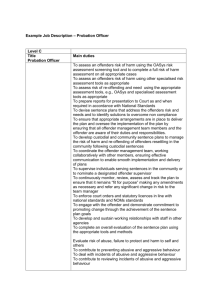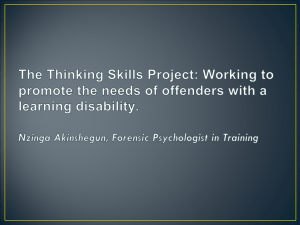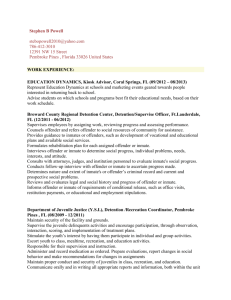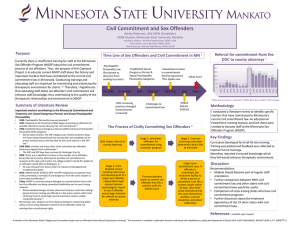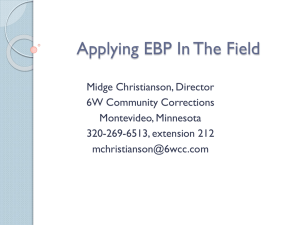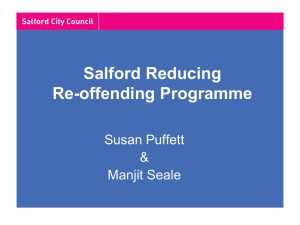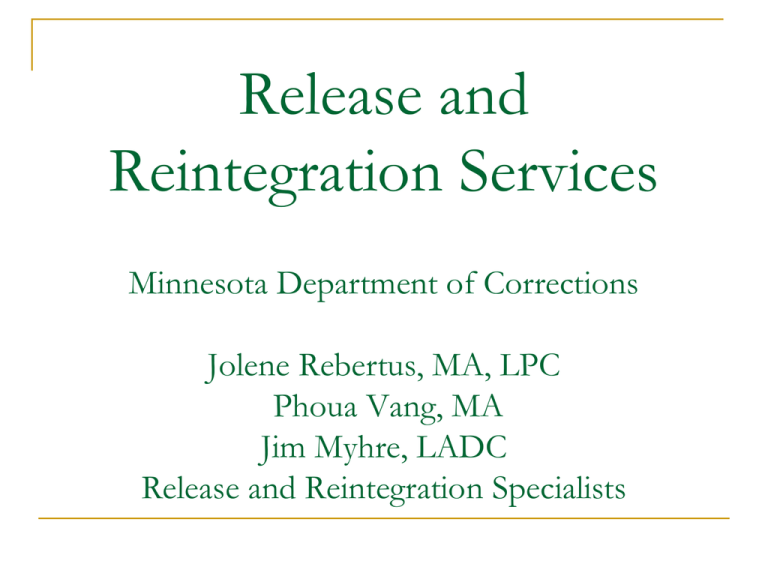
Release and
Reintegration Services
Minnesota Department of Corrections
Jolene Rebertus, MA, LPC
Phoua Vang, MA
Jim Myhre, LADC
Release and Reintegration Specialists
Release Planning in
Behavioral Health
Approach
Prevention through planning and action
MN DOC Release Planners
SPMI
SO
CD
Medical
TBI
SPMI Release Planning
Function as a mental health practitioner
Assess and review client management needs
Create individualized discharge plan aimed at
successful integration into the community
Introduction
Significant increase in awareness of number
of mentally ill offenders in prison population
Results in homelessness, unemployment,
hospitalizations, subjection to abuse and
exploitation, alcohol and drug dependence
Introduction
2002, MN State Legislature passed law
requiring mental health release planning for
all SPMI offenders
Community mental health services preplanned
prior to release
Importance of Mental Health Release
Planning Services
Enhance community safety
Reduce recidivism
Meet state legislatively mandated laws
Provide advanced notification to community
social service agencies
Importance of Mental Health Release
Planning Services
To ensure offender access to state, county,
and federal health care
Transition mental health services from prison
to community
Medically based treatment that supports
court’s objectives and conditions for release
Best possible aftercare for SPMI offenders
Definition of Serious and Persistent
Mental Illness (SPMI)
A person has diagnosis of:
Schizophrenia
Bipolar Disorder
Major Depressive Disorder
Borderline Personality Disorder
Schizoaffective Disorder
How to identify?
Past records
Pre-sentence investigations
Clinical records
Case notes
Police reports
Offender interview
Have you ever been hospitalized?
Have you seen a counselor or therapist?
Do you have a mental health diagnosis?
Medications?
Mental Health Release Plan
Begin working with offender 120 days prior to
release
Voluntary Service
Limits of Confidentiality
Assessment of need completed
Obtain emergency contact, recreational
activities, etc.
Mental Health Release Plan
County Mental Health Case Management
Rule 79 Assessment
Each county has their own rule 79 assessment
Certifies a person with a serious and persistent mental illness
County involvement important in order to assist with
connecting offender to community mental health resources
Day tx.
MI/CD groups
Vocational programming
Housing Funds
Mental Health Release Plan
ARMHS-Adult Rehabilitative Mental Health
Services
Medical Assistance required
Intensive Community services that focus on
offender’s mental health stability in community
Mental Health Release Plan
MN Department of Economic Assistance
GAMC (expired 02/28/11)
MN Care
MA Expansion (March 2011)
SMRT
Food Stamps
Personal Needs Money
Mental Health Release Plan
Financial Benefits-Social Security
Multi-stage process
Referral phone call to SSA representative at 120 days
SSI phone interview with offender in prison
Completion of important paperwork
Possible psychiatric evaluation
SSI provide a means of support to pay for housing, food,
and increase the offender’s health insurance coverage
Mental Health Release Plan
Housing Placement
SPMI release planner involved in order to find
appropriate housing
Rule 25 assessment for MI/CD programming
Collaboration with various providers
Community agencies
Case manager
Housing manager
Economic Assistance
DOC case manager
Field agent
Mental Health Release Plan
Community appointments
Outpatient Psychiatry-medication monitoring
Outpatient Psychology-primary therapist
Community Treatment Program
Sex offender
MI/CD
DBT
Day treatment
Mental Health Release Plan
Prevention Plan
Reviewed and processed with the offender
To improve his/her cognitive thinking skills
Build self-confidence in managing their mental health in
the community
Sex Offender Release Plan
Philosophy
Release planning starts at program admission
Re-entry services is provided in an inside-out
manner
Community resources are brought into the institution
Interagency collaboration establish pre-release
Sex Offender Release Plan
Release Planners in SOTP:
Educate and motivate offenders in assessment
phase
Assess and review continuum of care needs
Act as a resource
Ensure safe continuum of care plan
SOTP Transitions
4 - 6 months prior to release
1.5 hours, 4 days per week for 12 weeks
SOTP Transitions
Guest speakers & Topics
Community notification & registration
Supervision
Civil comm. procedures
Housing resources and program expectations
Vocational
Parenting, visitation & family reunification
Outpatient treatment
Support groups
Credit counseling & child support
SOTP Transitions
Support Person Education Sessions
Members of offenders support network
Family, friends, sponsors, mentors, pastors
Held in institution visiting area during non-visiting
days
Large group discussion (all offenders and guests)
Small group discussion (therapist, offender & his
guests)
Sex Offender Release Planning
Release Planning Session
Supervising Agent
SOTP therapy staff
DOC Case Manager
Community support people
Discuss tx. progress and concerns
Review and modify release plan
Goals and rec. for release
Rules & regulations of release
Sex Offender Release Plan
Offender Participates in putting the plan
together
Directed by housing placement
Identify resources:
Assistance needs (medical, financial, etc.)
Continuing treatment resources
Support groups
Leisure, education, community involvment
Sex Offender Release Plan
OBSTACLES
Limited resources for residency
Delays in civil commitment determination
Lack of healthy support resources
Limited funds
Lack of transportation
Chemical Dependency Release Plan
Basic Approach
Actively work toward creating a community
release plan by identifying supportive services,
and utilizing all available resources offered by the
Department of Corrections
Prioritizing CD Services
HIGH, MEDIUM, or LOW
CD assessment
DWI offense
LSI Score
MNSOST-r Score
Assault, harm, weapon
Mental health
TBI
Developmental Disability
Chemical Dependency Release plan
Release Planning Clientele
Offenders participating in CD programs
Offenders releasing directly into the community
6 months prior to release
Other Planning Strategies
Early Release Programs
ICWC
Work Release
Minimum Security
Offenders in the General Population
Courtesy Rule 25’s
Chemical Dependency Release Plan
Multi-disciplined Approach
Offender involvement
Assess and review client management needs
Case managers
Supervising agents
LSI domains
CD Comprehensive Assessment
Staff review and consult
County input – Rule 25
Create individualized discharge plan aimed at
successful reintegration into the community
Chemical Dependency Release Plan
Addressing Other Needs
Sober housing
Medical
Mental health
Employment
Family and community support system
Personal needs
Leisure and recreation
Chemical Dependency Release Plan
Integration of Community Services
County Human Services
Social Services
Re-Entry Service Agencies
CORP – Duluth
Wilder Foundation – St. Paul
HIRE – Minneapolis
Workforce Centers
Easter Seals – Twin Cities, Rochester, Wilmar
Central MN Re-Entry Project – St. Cloud & Central MN
Summary and Key Points
Frequent communication with various parties
Within Department of Corrections
Community agencies
Field agents

